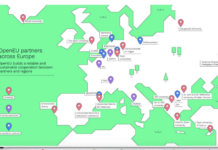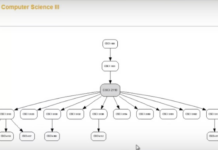Overview of this edition
IRRODL (International Review of Research in Open and Distance Learning), Volume 15, Number 1 is now available, for free downloading as open educational resources.
Once again, this is an invaluable resource on the latest research in open and distance learning from authors in 15 countries/regions, covering the following topics (thanks to Diane Conrad, the co-editor, for this classification of otherwise disparate articles):
- cultural aspects (impact of DE on First Nations/aboriginal communities in Canada; community and identity in MOOCs; DE and gender in Saudi Arabia; and cultural issues affecting DE in South Korea)
- MOOCs and OERs
- evaluation of different technologies used in DE
- effective teaching approaches or factors influencing this.
Altogether this journal consists of 15 articles. I will in later posts review at least some of the articles, but I want to focus this post on one paper in particular, because it deals with a particular important issue here in Canada.
Experiences of students in a rural First Nation
Simon, J. et al. (2014) Post-secondary distance education in a contemporary colonial context: Experiences of students in a rural First Nation in Canada
This paper, written jointly by two First Nations people and two academics from the University of New Brunswick, is focused on distance education in a M’kmaw community in Atlantic Canada (New Brunswick). It is unusual as it seeks the views of 20 aboriginal students from the Elsipogtog First Nation in New Brunswick who have taken distance education courses.
In a summary of previous research on DE and aboriginal education the authors note:
[Previous researchers have] found several innovative initiatives delivering high school and post-secondary education programs [into remote Aboriginal communities] by distance delivery that have achieved dramatic success. However, few education institutions and education directors know of these successful models and few have been able to learn from these experiences. The best practices…. include the involvement of on-site tutors, flexible delivery models, and the need to develop personal relationships between the students and instructors.
The Simon et al. study is unusual because it is based on the experience of First Nations students who had taken post-secondary distance education courses, gathered through in-person interviews. The authors’ conclusion:
Our study suggests that more support for and attention to the students’ preferences for learning styles will lead to more successful distance education programs in these communities. This suggestion aligns with the concept of “First Nations Control of First Nations Education” advocated by the Assembly of First Nations. It also suggests that more appropriate post-secondary distance education options will allow more families to remain in remote and rural First Nations while they study instead of moving to the cities, contributing to the long-term sustainability of their communities.
The First Nations University of Canada
There is only one post-secondary institution in Canada that is run by and for aboriginals, and that is the First Nations University of Canada (formerly the Saskatchewan Indian Federated College.) FNUniv’s courses, programs, and instructors are accredited by the University of Regina, a publicly funded provincial university in Saskatchewan, which is a partner of FNUniv. FNUniv currently has 800 full-time students. FNUniv is a unique Canadian institution that specializes in indigenous knowledge, providing post-secondary education for Aboriginal and non-Aboriginal students alike within a culturally supportive environment. Its Northern Campus in Prince Albert maintains the responsibility of coordinating and delivering community-based and distance education programs. FNUniv shows that it is possible to partner successfully with a recognized Canadian university, and many other Canadian universities run campus-based programs aimed at aboriginal students in partnership with local First Nations.
However, my understanding is that to date, FNUniv has not developed any distance education programs of its own, using mainly relevant and appropriate distance education courses from the University of Regina. Indeed I don’t know of any post-secondary courses or programs developed by aboriginals for aboriginals in Canada. (Please correct me if I’m wrong).
Comment
This article is essential reading for anyone interested in the potential and challenges of distance education for Canada’s First Nations. Once again, the problem is not that we don’t know what to do; it’s just that we don’t do it.
Aboriginal education in Canada is, in my view, a national disgrace: under-funded, neglected and incompetently managed by the federal government, and in some cases subject to incompetent or even corrupt management by some First Nations – and that’s without going into the appalling colonial history of aboriginal education in Canada, which is largely but not entirely the cause of the current situation.
There is a new agreement just recently negotiated between the federal government and the Assembly of First Nations that gives more control over the management of their schools by First Nations, and also increased funding. It will though be operated completely separately from the provincially managed school system, and will still be underfunded in comparison.
At the same time, although a number of universities and colleges run special programs for aboriginal students, there are almost no post-secondary distance education programs designed specifically for First Nations communities. (If there are, please let me know)
I have heard it argued that distance education is not appropriate for First Nations. I don’t believe this. Distance education programs that are not designed or are not adapted to the needs of First Nations may not be appropriate for many aboriginal people living on reserves. But I do believe it is possible for online or hybrid programs to be successfully delivered into First Nations if they are designed specifically for this purpose, and that means involving aboriginal people in both designing and supporting such programs.
Therefore I believe the time is more than due for the development of post-secondary distance programs by aboriginals for aboriginals that take account of their cultures and languages. The challenge is that there is not one aboriginal community but over 600 different First Nations, with over 60 languages in 12 distinct language groups, within Canada. Thus achieving economies of scale is really difficult. Nevertheless, there is a great deal of communality between First Nations, not only within Canada, but internationally. Digital technology now enables ‘core’ materials to be developed that can be adapted and/or supplemented to reflect differences between First Nations, especially if they are created as open educational resources.
What is lacking though is an online or hybrid program designed and managed by aboriginal peoples that reflects the realities and the cultural needs of the aboriginal groups at which it is aimed. If anyone knows of any such initiative that aims to deliver programs remotely into First Nations’ communities that leads to recognized post-secondary qualifications while still being designed and delivered primarily by aboriginal people themselves, I would love to learn about it. In the meantime, perhaps the Assembly of First Nations could take a look at the possibility of a national online program of some kind.
Next
I’d love to hear from aboriginal educators on this topic, from both within and outside Canada.
In the meantime, I will cover some of the other excellent articles in this issue of IRRODL in another post.











 Dr. Tony Bates is the author of eleven books in the field of online learning and distance education. He has provided consulting services specializing in training in the planning and management of online learning and distance education, working with over 40 organizations in 25 countries. Tony is a Research Associate with Contact North | Contact Nord, Ontario’s Distance Education & Training Network.
Dr. Tony Bates is the author of eleven books in the field of online learning and distance education. He has provided consulting services specializing in training in the planning and management of online learning and distance education, working with over 40 organizations in 25 countries. Tony is a Research Associate with Contact North | Contact Nord, Ontario’s Distance Education & Training Network.


Correction: as well as First Nations University in Saskatchewan, Blue Quills First Nations College (BQFNC) is a locally controlled Indigenous education centre located approximately 200 kilometres northeast of Edmonton, Alberta. It offers several degree and non-degree programs. Thanks to Bob Kennedy for this information – and my apologies to Blue Quills.
In BC, there is the Nicola Valley Institute of Technology (NVIT) that is also a First Nations college. http://www.nvit.ca
Hi, Fabian
Many thanks for the information about Nicola Valley Institute of Technology. I also note that they have a couple of online courses. Your feedback is very much appreciated,
Prof. Jean-Paul Restoule at the University of Toronto delivered a MOOC on “Aboriginal Worldviews and Education” on Coursera. It is not aimed at First Nations people, but it was particualrly good at highlighting issues faced by aboriginal communities. It may be worth contacting Prof. Restoule.